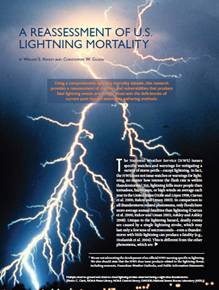A Reassessment of U.S. Lightning Mortality
 The National Weather Service (NWS) issues specific watches and warnings for mitigating a variety of storm perils – except lightning. In fact, the NWS does not issue watches or warnings for lightning, no matter how intense the flash rate is within thunderstorms.
The National Weather Service (NWS) issues specific watches and warnings for mitigating a variety of storm perils – except lightning. In fact, the NWS does not issue watches or warnings for lightning, no matter how intense the flash rate is within thunderstorms.
Yet, lightning kills more people than tornadoes, hurricanes, or high winds on average each year in the U.S. In comparison to all thunderstorm-related phenomena, only floods have more average annual fatalities than lightning. Unique to the lightning hazard, deadly events are caused by a single lightning stroke, which may last only a few tens of microseconds – even a thunderstorm with little lightning can produce a fatality. This is different from the other phenomena, which are considerably larger in time and space and therefore require more ingredients for their occurrence.
In the American Meteorological Society's publication, Ashley and Gilson seek to reassess and update the findings from contemporary literature on lightning mortality by first investigating the strengths and deficiencies of existing fatality data sources that were employed by these prior studies.
Read the publication (1.44MB): A Reassessment of U.S. Lightning Mortality
By Walker S. Ashley, Christopher W. Gilson
Meteorology Program, Department of Geography, Northern Illinois University
Related links:
NOAA’s National Weather Service
National Weather Service Lightning Safety